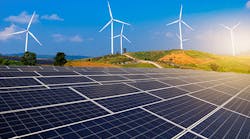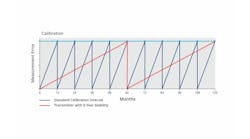In my book Controlling the Future (to be published in the fall of 2021), I analyze the global warming (GW) process as if it was an extremely complex, multivariable, industrial heat-balance process. This approach is unique because it's based on the actual dead times, time constants, inertias and feedback interactions of this process as they've been observed during the past century.
My analysis shows climate change is accelerating as our energy footprint has increased some 30-fold. This caused a rising of global temperatures from a mean of 14.1 °C to over 15.1 °C today. While GW is a heat-balance process and the rules of process control apply, we must also realize that the coolant (the manipulated variable) in this loop is human behavior that's neither logical or predictable.
The control valve of the loop
The effectiveness of a control loop increases as the size and speed of the associated control valve increases. Yes, but what is the manipulated variable in the GW control loop that has to be throttled to cool the process? Here the manipulated variable is human behavior, which responds differently than a control valve! A coolant valve moves as soon as its actuator moves, while human behavior has a period of inaction followed by slow response (decades, if not generations). This dead time and time constant are long because opening the human mind is much slower than opening a valve because it depends on education. Therefore, to stop GW, we need a faster and more effective final control element—and that is money! The only manipulation to which people respond quickly is financial self-interest, and the free market is an ideal vehicle to deliver it.
We can eliminate climate change by changing human behavior through carbon taxation, carbon offsets and by reducing the profitability of burning fossil fuels. It's also essential that the collected monies be invested in green energy development. Once green energy is cheaper and more convenient than fossil energy, transformation becomes automatic (the coolant control valve opens).
Continuing with the industrial analogy, in addition to opening the coolant valve we must also remove some of the restriction orifices that are in the pipeline of change. One such resistance is the false propaganda of the denialists; the other is the political influence of the fossil fuel lobby. In my view, if conversion to green energy is made profitable and if the fossil lobby is forced to admit these facts, the GW control loop can become effective.
It's also desirable to provide two setpoints for the GW controller. The first setpoint should be based on our immediate goal of leveraging the fastest acting coolants (albedo, renewable solar-hydrogen, carbon capture, etc.) and then setting the ultimate goal—transformation into a completely new energy infrastructure and a new lifestyle that makes our peace with nature. This ultimate energy economy will be completely carbon-free, inexhaustable and dependent on solar energy. Where collectors and users are in the same location, generated electricity will be used directly, and where users are elsewhere, generated electricity will be converted into hydrogen for storage and transport.
Reading this paragraph, my poor father would have said, "And then you wake up? Have you read a newspaper lately?” I know most of you would probably agree with my father. My goal in writing this book is to show that the situation isn't hopeless and that this conversion can be made.
In addition to lowering GW by eliminating carbon emissions, we can also reduce global temperature indirectly by increasing direct cooling of the planet. One such direct cooling tool is the opening of the "albedo valve.” Albedo is a unit of reflectivity. The lighter the surface of an object, the more reflection is produces. Today, the global total of heat reflected back into outer space is about 30% (albedo = 0.3). I calculate that if we could increase this reflection by only 1% (to an albedo of 0.31), the resulting cooling effect alone would stop GW. Albedo-based cooling requires a "whitening” of the human footprint. This can be done inexpensively and quickly, by whitening our roofs, roads and agricultural surfaces.
Figure 1: The carbon emission into the atmosphere is 9-10 billion tons per year (CO2 33 to 34 BTy) and rising. The CO2 concentration in the air is about 410 ppmv (the pre-industrial concentration was 280 ppmv) and is also rising by about 3.0 ppmv per year. This means that today the daily per capita CO2 emission of mankind is about 13kg/day (44 kg in the USA, 33-Russia, 21-China, 18-EU, 6-India, 1-in the underdeveloped world).
Building the GW control loop
Upsetting the balance of the earth’s carbon cycle (Figure 1) resulted in the upset of the dual-capacity GW process. This process consists of two sub-processes, one is slow (oceans) the other is fast (atmosphere). This is because the mass of the oceans is a couple of hundred times greater than that of the atmosphere. This is the reason why atmospheric processes respond faster to an upset in the planet's heat balance than the oceans. Consequently, the atmosphere in some locations has already warmed by some 4-5 °C, causing melting in the Arctic and severe droughts, wildfires, heat waves, water shortages, hurricanes, flooding and destruction of wildlife. In contrast, the effects of GW resulting in changing oceanic processes, such as thermal expansion, ocean currents, El Nino, are just getting started.
One of the rules of process control is that when the upsets of a long time constant and large-capacity process start to be combined with that of a faster one, the upset accelerates and can reach an irreversible tipping point. In my book, I show that if we don't act in this decade to curtail GW, we'll reach such a tipping point, where the rate of GW rise will double from the present 0.25 °C per decade to about 0.5 °C per decade. This means GW will exceed the 1.5 °C Paris Treaty limit by 2030.
If we are to stay under the 2.0 °C limit, my calculations indicate that, in addition to introducing carbon offsets or carbon taxes, it's also essential to invest the collected sums in financing the development of green energy. In addition, the building of new fossil power plants must be stopped immediately and the burning of all fossil fuels must be discontinued by 2030-35. In other words, we must eliminate the causes of climate change instead of trying to live with its symptoms. This means that we must not spend trillions on climate adaptation—building walls, designing hurricane- or flood-resistant housing, investing in moving residents away from the shores, or converting to drought-resistant agriculture—but must eliminate their cause by converting to using green energy.
In my book, I conclude that keeping GW under the limit of 1.5 °C is hopeless, and staying under 2.0 °C is unlikely. This is because serious action by the 200 or so nations on our planet hasn't even started.
If this process were an industrial one, we'd conclude that a herding cascade control system must be implemented, where the cascade master throttles the setpoints of all the herded slave loops. Well, in case of GW control, a lot of hot air has been generated, but no cascade master established. As I've already mentioned, the cascade master must be financial interest through the introduction of carbon tax to the tune of $50 per ton of carbon dioxide emitted. This rate should increase by about 5% every year, and the collected monies should be invested in green energy R&D. Naturally, for this herding control system to work, corporations as well as nations should have a financial interest in introducing these harsh measures.
Unfortunately, we continue to move in the opposite direction. Today. the spread of isolationist nationalism is in conflict with the urgent need for global climate action. In fact, some nations did not even sign the Paris Treaty (China, India and Russia). And on top of that, China openly plans to keep increasing its carbon emissions until 2050. As to the signers, their attention is focused on the pandemic, economic recovery and cyber-terrorism. They, too, are still building pipelines, continuing to burn coal, and their emissions are still rising.
In my next columns, I'll describe some of the measurement and control challenges facing our conversion to a carbon-free future.





